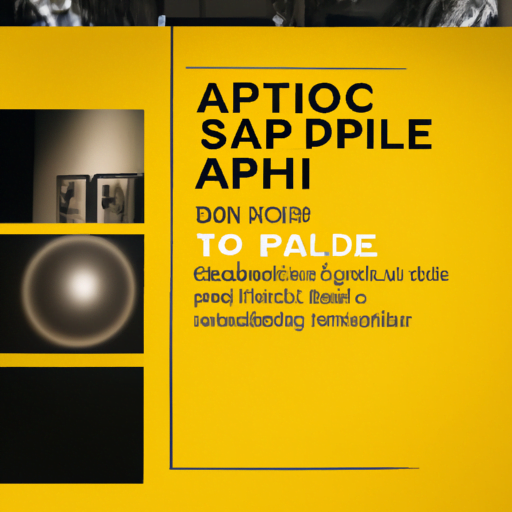
-
Table of Contents
- Typography in Exhibition Design: Guiding Visitors through Space
- The Power of Typography in Exhibition Design
- Strategies for Utilizing Typography in Exhibition Design
- 1. Establish a Visual Hierarchy
- 2. Consider the Exhibition Environment
- 3. Align Typography with the Exhibition Theme
- 4. Experiment with Typography as Art
- 5. Use Typography to Create Pathways
- Case Studies: Effective Typography in Exhibition Design
- 1. The Museum of Modern Art (MoMA) – “Bauhaus: Workshops for Modernity”
- 2. Victoria and Albert Museum (V&A) – “David Bowie Is”
- Conclusion
Typography in Exhibition Design: Guiding Visitors through Space

Typography plays a crucial role in exhibition design, serving as a powerful tool to guide visitors through space and enhance their overall experience. When used effectively, typography can convey information, evoke emotions, and create a cohesive narrative within an exhibition. In this article, we will explore the importance of typography in exhibition design and discuss various strategies and best practices for utilizing typography to guide visitors through space.
The Power of Typography in Exhibition Design
Typography is more than just selecting fonts and arranging text; it is a visual language that communicates with visitors on a subconscious level. The right typography can set the tone, establish hierarchy, and create a sense of place within an exhibition. Here are some key reasons why typography is essential in exhibition design:
- Information Hierarchy: Typography helps visitors navigate through an exhibition by guiding their attention to important information. By using different font sizes, weights, and styles, designers can create a clear hierarchy that directs visitors’ focus.
- Branding and Identity: Typography can reinforce the branding and identity of an exhibition. Consistent use of fonts and typographic elements can create a cohesive visual language that aligns with the exhibition’s theme or message.
- Emotional Impact: Typography has the power to evoke emotions and set the mood within an exhibition. The choice of fonts, letterforms, and spacing can create a sense of excitement, tranquility, or urgency, depending on the desired atmosphere.
- Enhancing Accessibility: Typography plays a crucial role in making exhibitions accessible to all visitors. Clear and legible typography ensures that information is easily readable, accommodating individuals with visual impairments or reading difficulties.
Strategies for Utilizing Typography in Exhibition Design
Now that we understand the importance of typography in exhibition design, let’s explore some strategies and best practices for utilizing typography effectively:
1. Establish a Visual Hierarchy
Creating a clear visual hierarchy is essential to guide visitors through an exhibition. By using different font sizes, weights, and styles, designers can emphasize important information and guide visitors’ attention. For example, larger and bolder fonts can be used for headings and titles, while smaller and lighter fonts can be used for supporting text.
2. Consider the Exhibition Environment
When selecting typography for an exhibition, it is crucial to consider the environment in which it will be displayed. Factors such as lighting, background colors, and viewing distances can impact the legibility and visibility of typography. Designers should choose fonts that are easily readable in the given conditions and ensure sufficient contrast between the text and background.
3. Align Typography with the Exhibition Theme
Typography should align with the exhibition’s theme or message to create a cohesive visual language. For example, a historical exhibition may use serif fonts to evoke a sense of tradition and authenticity, while a contemporary art exhibition may opt for sans-serif fonts to convey a modern and minimalist aesthetic. Consistency in typography helps reinforce the exhibition’s identity.
4. Experiment with Typography as Art
Typography can be more than just a means of conveying information; it can also be a form of art. Designers can experiment with creative typography to add visual interest and engage visitors. For example, using unconventional letterforms, incorporating typographic illustrations, or playing with spacing and alignment can create unique and memorable experiences within an exhibition.
5. Use Typography to Create Pathways
Typography can be used strategically to guide visitors through an exhibition space. By placing directional signage, labels, or captions strategically, designers can create visual pathways that lead visitors from one section to another. Consistent typography throughout the exhibition helps visitors navigate and understand the flow of the space.
Case Studies: Effective Typography in Exhibition Design
Let’s explore some real-world examples of exhibitions that have effectively utilized typography to guide visitors through space:
1. The Museum of Modern Art (MoMA) – “Bauhaus: Workshops for Modernity”
In this exhibition, typography played a central role in conveying the Bauhaus movement’s principles of simplicity and functionality. The use of sans-serif fonts, clean layouts, and consistent typographic hierarchy created a sense of modernity and reflected the Bauhaus aesthetic. Visitors were guided through the exhibition seamlessly, with clear typography indicating different sections and providing contextual information.
2. Victoria and Albert Museum (V&A) – “David Bowie Is”
The typography in the “David Bowie Is” exhibition at the V&A Museum perfectly captured the essence of the iconic musician. The use of bold and expressive fonts, combined with unconventional layouts and typographic illustrations, reflected Bowie’s artistic persona. Typography was used not only to guide visitors but also to immerse them in Bowie’s world, creating a multisensory experience.
Conclusion
Typography is a powerful tool in exhibition design, guiding visitors through space and enhancing their overall experience. By establishing a visual hierarchy, aligning typography with the exhibition theme, and considering the environment, designers can create a cohesive and engaging narrative within an exhibition. Through case studies like MoMA’s “Bauhaus: Workshops for Modernity” and V&A’s “David Bowie Is,” we have seen how effective typography can create memorable and immersive experiences for visitors.
Next time you visit an exhibition, pay attention to the typography used and how it guides you through the space. Typography is not just about words; it is a visual language that shapes our understanding and perception of the exhibition. So, let typography be your guide as you explore the fascinating world of exhibitions.
